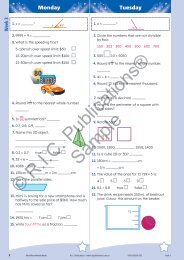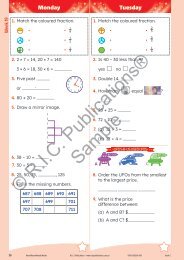PR-0552UK Primary Science - Book 2
Create successful ePaper yourself
Turn your PDF publications into a flip-book with our unique Google optimized e-Paper software.
Observing frogs<br />
Caring for my locality ~ Activity 4<br />
Objective<br />
• observe and develop an<br />
awareness of living things in a<br />
range of habitats in local and<br />
wider environments<br />
Working scientifically<br />
• Questioning<br />
• Observing<br />
• Predicting<br />
• Investigating and<br />
experimenting<br />
• Recording and communicating<br />
Designing and making<br />
• Exploring<br />
Background information<br />
Collecting animals for observation<br />
should only be done if the animals<br />
are not harmed. In the case of this<br />
observation, a good supply of water<br />
and food will ensure the survival<br />
of the tadpoles. Once developed<br />
into frogs, the animals should be<br />
released into the environment<br />
where they were found.<br />
There are numerous Internet web<br />
sites that explore the life cycle<br />
of a frog and provide detailed<br />
information on it.<br />
Before the lesson<br />
Note: This lesson can be approached in two ways.<br />
(i) By collecting frogs eggs or tadpoles and observing their life cycle in class.<br />
(ii) By using only the worksheet to identify the life cycle of a frog.<br />
Materials needed<br />
• Frogs’ eggs or tadpoles, an aquarium or container for storing eggs/tadpoles,<br />
shallow water, rocks, water weed or pond weed, fish food (live from the pond<br />
or little pieces of hard-boiled eggs), a variety of resources on the life cycle of<br />
a frog.<br />
Preparation<br />
• Ensure your container is prepared using water from the same environment the<br />
eggs/tadpoles were collected from. Keep the terrarium away from heaters and<br />
chalk dust.<br />
• Collect posters, books or charts to show the life cycle of a frog.<br />
The lesson<br />
Stimulus<br />
• The stimulus for this lesson could involve a field trip to collect frogs’ eggs or<br />
tadpoles. Alternatively, the eggs/tadpoles could be collected prior to the lesson<br />
and introduced to the prepared enclosure at this time. Use collected resources<br />
on the frog life cycle to discuss with pupils.<br />
What to do<br />
• Using the worksheet, show the pupils the change that is expected over the<br />
coming weeks as the tadpoles develop into frogs.<br />
• Frog observations should occur weekly. The pupils record development and<br />
compare changes from the previous week.<br />
• At each observation, pupils should identify the stage of development.<br />
After the lesson<br />
Answers<br />
• Teacher check<br />
Additional activities<br />
• Identify frogs native to the local environment.<br />
• Use books and the Internet to identify unique and interesting frogs. Research<br />
the countries they live in.<br />
• Explore how frogs are seen as a key objective to the stability and health of an<br />
environment/ecosystem.<br />
Viewing Sample<br />
Display ideas<br />
• Take photographs of the pupils collecting the frogs and tadpoles, and introducing<br />
them to their new environment. Display with appropriate captions.<br />
• Identify frogs from around the world. Display drawings and research about<br />
each frog around a world map. Use string to show the country where they can<br />
be found.<br />
106 <strong>PR</strong>IMARY SCIENCE ~ Prim-Ed Publishing ~ www.prim-ed.com


















